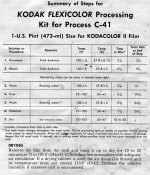- Messages
- 489
- Name
- MARINO
- Edit My Images
- No
Film gurus could you please share your knowledge,i have a few questions that google can’t answer 
im currently shooting film and stopped shooting digital because it makes things complicated. Too many options make things worse for me.
first question is what colour film would you recommend for a beginner? I’ll be shooting at daytime and nighttime with artificial light.
Second question is, should i bother developing colour film on my own or is it not worth it? (I already have the equipment for developing since I develop b&w on my own).
And the last , is it worth getting a film scanner? I would use it for archiving and printing family photos and maybe every once in a while an a4 print. If yes, what would you recommend?
Thx
Marino

im currently shooting film and stopped shooting digital because it makes things complicated. Too many options make things worse for me.
first question is what colour film would you recommend for a beginner? I’ll be shooting at daytime and nighttime with artificial light.
Second question is, should i bother developing colour film on my own or is it not worth it? (I already have the equipment for developing since I develop b&w on my own).
And the last , is it worth getting a film scanner? I would use it for archiving and printing family photos and maybe every once in a while an a4 print. If yes, what would you recommend?
Thx
Marino



